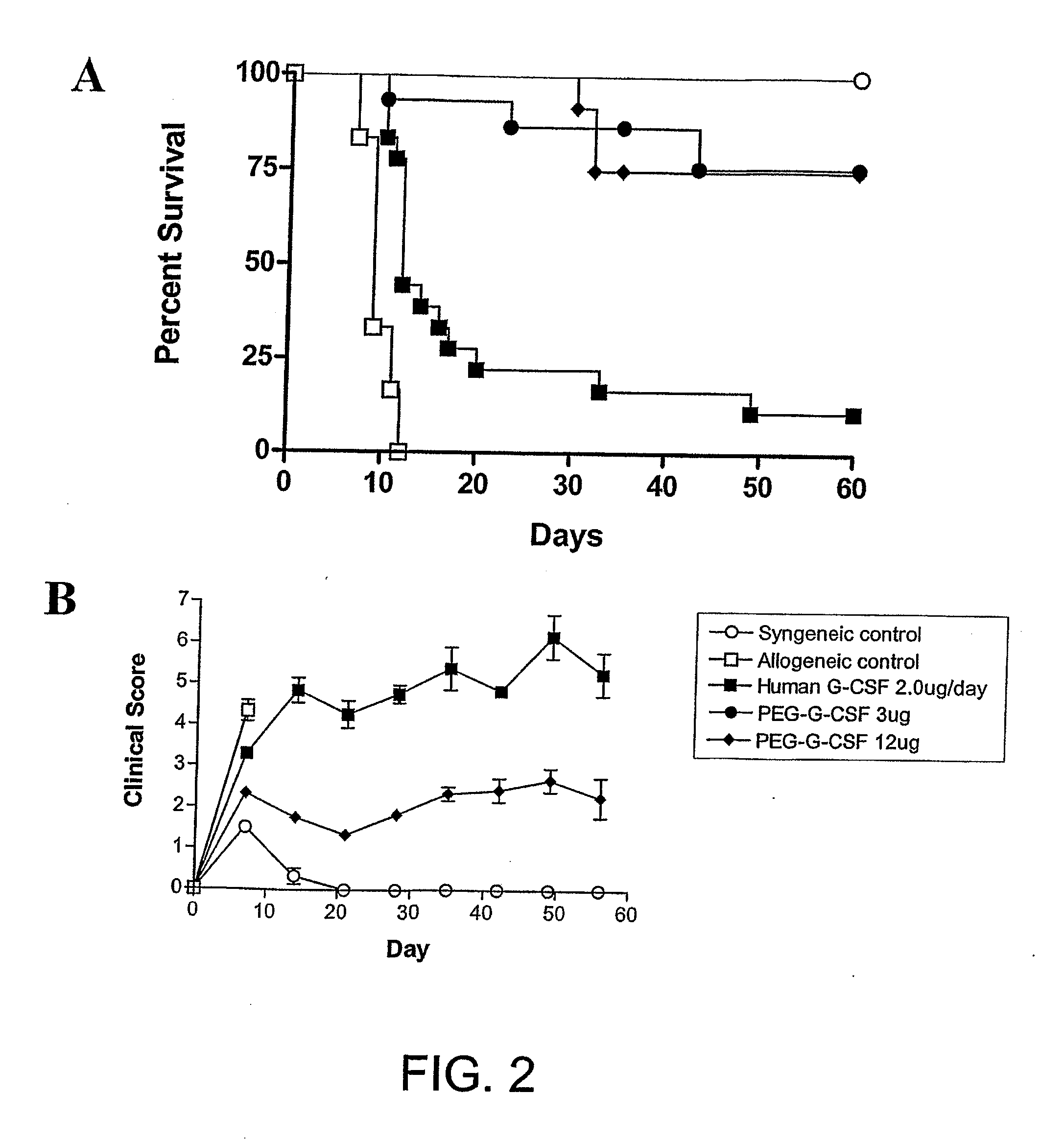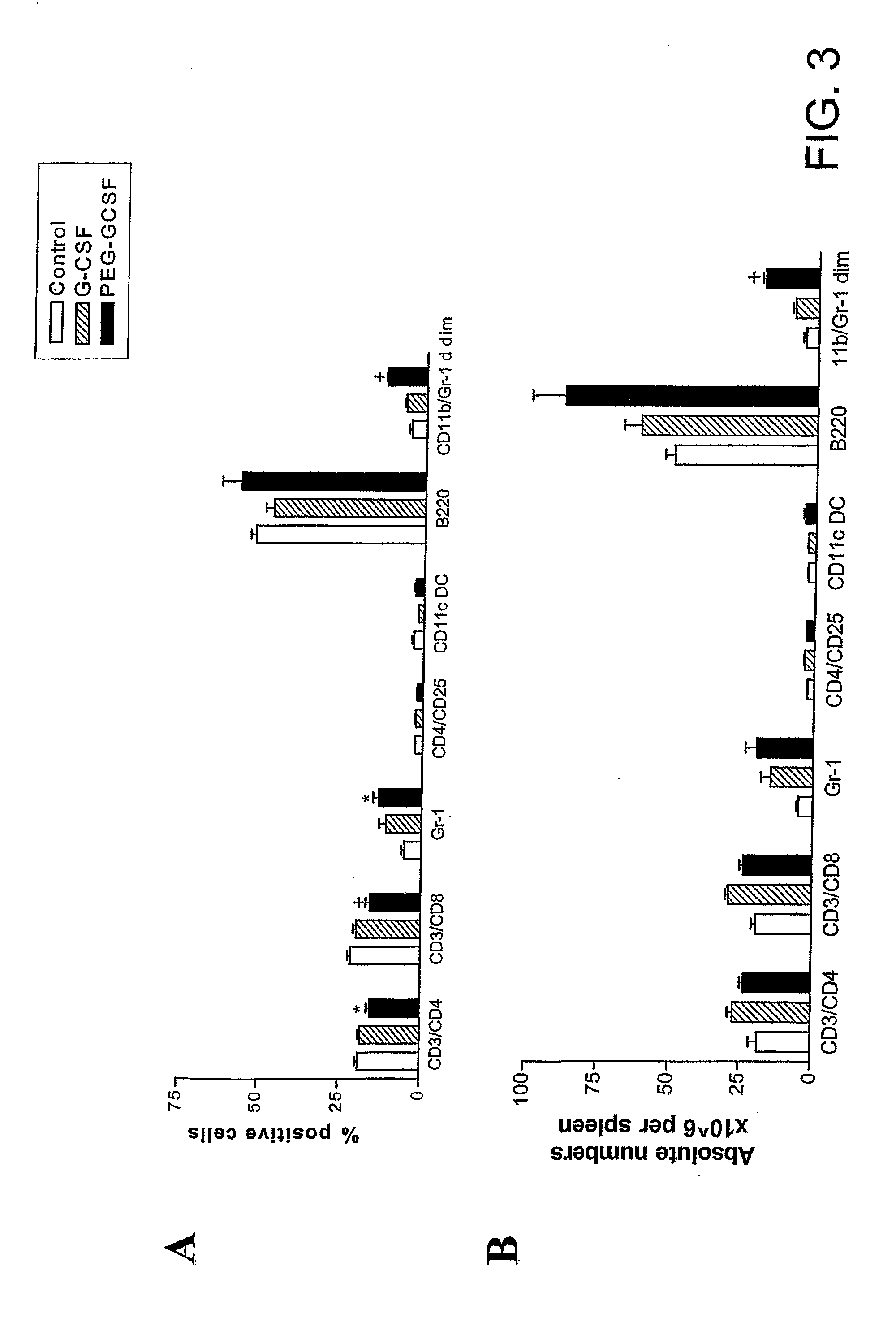G-csf derivative for inducing immunological tolerance
a technology of immunological tolerance and derivative, which is applied in the field of immunological tolerance, can solve the problems of multi-organ damage, limited use of allogenic sct, and significant impairment of overall transplant survival by immune deficiency, so as to prevent, treat or reduce an autoimmune disorder of the patient.
- Summary
- Abstract
- Description
- Claims
- Application Information
AI Technical Summary
Benefits of technology
Problems solved by technology
Method used
Image
Examples
example 1
Methods
[0204]Mice. Female C57BU6 (B6, H-2b, Ly-5.2+), B6 PTRCA Ly-5a (H-2b, Ly-5.1+) and B6D2F1 (H-2b / d, Ly-5.2+) (Morse et al, 1987) mice were purchased from the Australian Research Centre (Perth, Western Australia, Australia). C57BL / 6 IL-10− / − mice (B6, H-2b, Ly-5.2+) supplied by the Australian National University (Can berra, Australia). The age of mice used as BMT recipients ranged between 8 and 14 weeks. Mice were housed in sterilised microisolator cages and received acidified autoclaved water (pH 2.5) and normal chow for the first two weeks post BMT.
[0205]Cytokine treatment. Murine G-CSF (Amgen, Thousand Oaks, Calif., USA), recombinant human G-CSF (Amgen, Thousand Oaks, Calif., USA), pegylated recombinant human G-CSF (peg-G-CSF) (Amgen, Thousand Oaks, Calif., USA) or control diluent was diluted in 1 ug / ml of murine serum albumin in PBS before injection. Mice were injected subcutaneously with doses of murine or human G-CSF from days −6 to −1, or peg-G-CSF on day −6 at doses as s...
example 2
Donor Pre-Treatment with Recombinant Human G-CSF Prevents GVHD in a Dose-Dependant Fashion
[0214]The present investigators examined the effect of incrementally increasing the dose of G-CSF administered to SCT donors in a well-established murine SCT model (C57BL / 6 Ly5a→B6D2F1) that induces GVHD to major and minor histocompatibility antigens. Although this model utilises spleen as a stem cell source rather than peripheral blood, it's validity has been proven by informative data indicating beneficial effects of G-CSF on both GVHD and GVL (Pan et al, 1995; Pan et al, 1999) that have since been confirmed clinically (Bensinger et al, 2001). Allogeneic donor C57BL / 6 animals received 6 daily injections of either control diluent, 0.2 μg human G-CSF, 2 μg human G-CSF or 10 μg human G-CSF and spleens were harvested on day 7. B6D2F1 recipient mice received 1100 cGy of TBI, and splenocytes (corrected to administer 3×106 T cells per inoculum) transplanted intravenously from respective donors the f...
example 3
Donor Pre-Treatment with Murine G-CSF Provides Equivalent Protection to Human G-CSF from GVHD at a 10-Fold Lower Dose
[0215]The present investigators sought to determine the relative efficacy of murine G-CSF to prevent GVHD compared to human G-CSF. Allogeneic donor C57BL / 6 animals received 6 daily injections of either control diluent, 0.2 μg murine G-CSF, 0.5 μg murine G-CSF or 2 μg murine G-CSF. As shown in FIG. 1b, donor pre-treatment with 0.2 μg, 0.5 μg or 2 μg of murine G-CSF again provided dose dependant protection from GVHD lethality, with survival at day 60 of 17%, 33% or 75% respectively (P<0.05). Survival at day 60 for recipients of splenocytes pre-treated with 0.2 μg of murine G-CSF was equivalent to recipients of splenocytes pre-treated with a ten-fold higher dose of human G-CSF (0.2 μg murine G-CSF day 60 survival 17% versus 2.0 μg human G-CSF day 60 survival 11%, P=0.63).
PUM
| Property | Measurement | Unit |
|---|---|---|
| weight | aaaaa | aaaaa |
| weight | aaaaa | aaaaa |
| weight | aaaaa | aaaaa |
Abstract
Description
Claims
Application Information
 Login to View More
Login to View More - R&D
- Intellectual Property
- Life Sciences
- Materials
- Tech Scout
- Unparalleled Data Quality
- Higher Quality Content
- 60% Fewer Hallucinations
Browse by: Latest US Patents, China's latest patents, Technical Efficacy Thesaurus, Application Domain, Technology Topic, Popular Technical Reports.
© 2025 PatSnap. All rights reserved.Legal|Privacy policy|Modern Slavery Act Transparency Statement|Sitemap|About US| Contact US: help@patsnap.com



